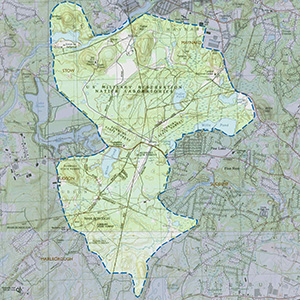Important Bird Area Sites in Massachusetts
Important Bird Area: Assabet River NWR
Site Summary
Nominated By
Tim Prior, Ron Lockwood
Size
4,925 acres
Towns and Counties
Hudson, Marlborough, Maynard, Stow, and Sudbury; Middlesex
Ownership
US Fish and Wildlife Service, Department of Conservation and recreation, federal military, municipal, private, nongovernmental organization
Major Habitats
55% northern hardwood forest, oak-conifer transitional forest, 5% cultural grassland, 15% emergent freshwater wetland, 20% shrub-scrub wetland
Land Use
Nature & wildlife conservation/land trust, hunting/fishing, quarry/gravel pit, research, military, undeveloped
Serious Threats
Invasive or non-native plants
IBA Criteria
- Category 1: Sites important for long-term research and/or monitoring projects that contribute substantially to ornithology, bird conservation, and/or education.
- Category 4: Sites containing assemblages of species characteristic of a representative, rare, threatened, or unique habitat within the state or region.
- Category 5: Land Birds: The site is an important migratory stopover or seasonal concentration site for migratory land birds (e.g., warblers). Sites may also qualify on the basis of supporting exceptionally high densities of breeding species as shown from point counts or other surveys or if they represent "migrant traps" relative to surrounding areas. Strong consideration will be given to areas with consistently high overall species diversity..
Site Description
This IBA is composed of the Assabet River National Wildlife Refuge (ARNWR), newly acquired by the USFWS, and adjacent undeveloped areas to the west and south. To the south of the refuge, the proposed IBA includes sections of Marlborough-Sudbury State Forest, the General Federation of Women's Clubs of Massachusetts Memorial Forest in Marlborough and Sudbury, the town of Sudbury Hop Brook Marsh conservation area, the city of Marlborough Desert Conservation Land, and undeveloped private land. Historically, the land that now makes up the ARNWR was farmed until it was acquired by the military for use as an ammunition depot during World War II. The forests are all second growth since prior to 1942 the property was farmed. The proposed IBA is composed largely of forests interspersed with wetlands. The landscape shows clear evidence of glacial activity including moraines, an esker, and kettle holes. The soils throughout much of the area are sandy, supporting a Pitch Pine and Scrub Oak forest. There is an Atlantic White Cedar swamp that straddles the boarder between the east side of the refuge and the Marlborough-Sudbury State Forest and extends onto unprotected private property. There are also several unconnected small grasslands that were maintained for military usage before the transfer.
Current Conservation Status
The land is primarily owned by USFWS, but includes undeveloped and unprotected private lands. At ARNWR, there are a series of sealed ammunition bunkers and decaying structures that date to the period of army usage. The refuge is closed to the public until the hazards associated with these decaying structures can be mitigated. USFWS has either applied or is considering the appropriate methods to control invasive species. These species include Japanese Knotweed, Spotted Knapweed, Common Reed, and Purple Loosestrife. The Purple Loosestrife is being biologically controlled.
Ornithological Significance
Least Bittern, probable breeder judging by behavior (personal observation); Cooper's Hawk, confirmed breeder; King Rail, responded to playback during Summer 2001 marsh bird surveys.
There is a great diversity of land bird species at this inland site.
The rare, unique, or representative habitats include an Atlantic White Cedar swamp, a small sandy-bottom kettle hole pond, several dwarf shrub bogs, open canopy minerotrophic peatlands, and areas of exposed sands. These community types are relatively infrequent in this area and harbor species uncommon to the region.
The USFWS has instituted long-term breeding bird surveys, marsh bird surveys, and hawk watches.
Other Flora or Fauna of Significance
Vernal pools are common and many have been certified by the Natural Heritage and Endangered Species Program.
Initial surveys indicate a variety of butterflies and moths, dragonflies and damselflies, reptiles, amphibians, and mammals in addition to the avian diversity. There is also a rich diversity of plants with several rare species.
Data Sources
Hunt, D. M. 1992. Floristic Survey, with Emphasis on Rare Species, of the Sudbury Annex of Fort Devens, Massachusetts. Contract No. DACA88-91-M-0873. U.S. Army contract unpublished report.
USFWS data: playback surveys at the ARNWR throughout the summer of 2001, annual breeding bird surveys using standardized point counts for both upland and marsh species (using a playback protocol), and fall of 2001 hawk watching on the ARNWR.
R. Lockwood, personal observations (much of which were subsequently published in Bird Observer). See the attached annotated list for those species that are on the Partners in Flight Watchlist.




